Durak is a unique and fun card game that originated in Russia. While uncommon outside this area, the game is very popular in many areas of Russia and the Ukraine and makes a great addition to any card player's repertoire of games.
The game is generally played by two to five players each playing independently. The game uses a deck consisting of 36 cards. This deck can be made by removing all cards of denominations 2, 3, 4, and 5 from a standard 52 card deck. The ranking of the cards used in this deck is as follows (from high to low); Ace, King, Queen, Jack, 10, 9, 8, 7, 6.
Selection of seating positions and first dealer can be performed using a variety of methods, with drawing for high card commonly used. Once this has been determined, the dealer shuffles the cards and offers the deck to the player to his right for the cut. After the cut, the dealer then distributes the cards to the players in a clockwise direction, face down and one by one. The dealer continues distributing the cards until each player has a total of six cards. The dealer then removes the bottom card from the remainder of the deck and places it face-up in the center of the table. The suit of this exposed card is then set as the trump suit for the hand. He then places the remainder of the pack partially on top of this card, usually set at a 90 degree angle to form the draw pile or talon.
The game consists of a series of rounds or "battles" which usually
consists of two players, one attacker and one defender. The player with
the lowest card of the trump suit in his hand will be the first attacker
and the player to his immediate left becomes the first defender.
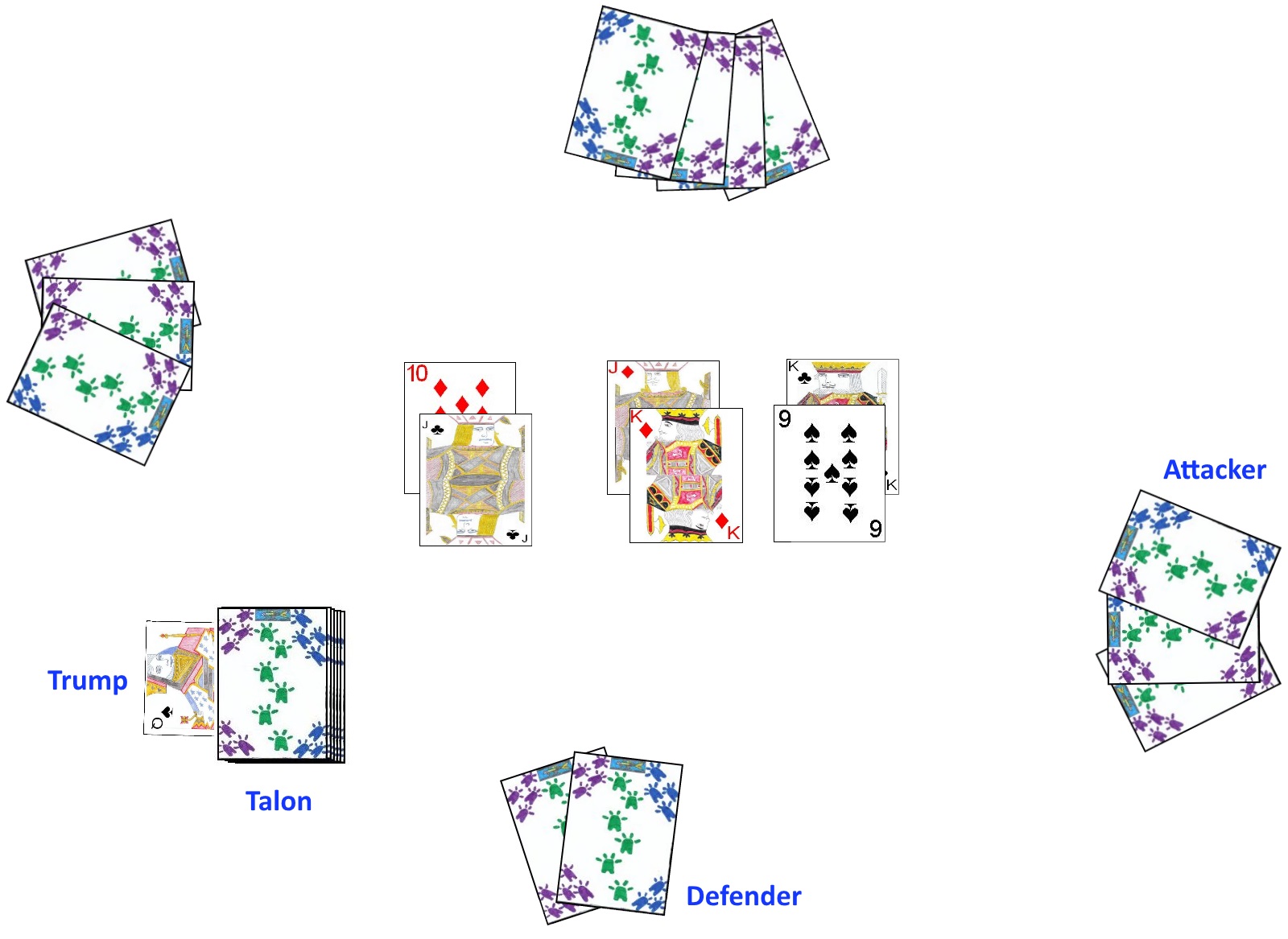
The attacker begins by selecting any card from his hand placing it
face up on the table. The defender must then respond by attempting to
play a higher card of his own if he has one. If a card of the trump suit
was played, any higher ranked card of the trump suit can beat it. If a
non-trump card was played, a higher ranked card of any suit can beat it,
as can any card of the trump suit. The defender's card should be played on
top of the attacker's card.
If the defender does not have (or elects not to play) a higher card
than the attacking card, he can concede defeat of the battle, and simply pick up the attacking card and add it to his hand. In this case the attacker is said to have won the battle.
However if the defender is able and elects to play a card higher than the attacking card he wins. In this case, the attacker as well as any other opponents (except the defender) may play additional cards to the table that the defender must also beat. Players may do this if they have a card of the same rank as a card that is currently still on the table (from this battle). However, they may not do so if the total number of current attacking cards exceeds the total number of cards remaining in the defender's hand. The
defender must then beat each of these additional attacking cards by playing a higher such card from his hand on top of the attacking card. If he is unable to beat every attacking card he must take every card currently played to the table. However, if the defender is able to beat each of the attacking cards, the defender prevails and is said to win the battle. When the defender wins the battle, all the cards currently played to the table are set aside to a discard pile, not to be used further in this hand.
If the original attacker wins the battle, the turn passes to the player to the immediate left of the last defender. That player becomes the new attacker and the player at his immediate left becomes the new defender. However, if the defender wins the battle instead, the defender becomes the new attacker and the player at his immediate left becomes the next defender.
After each battle, each player who has less than six cards in his hand then draws cards into his hand to replenish the hand back to six cards. The face-up, exposed trump card is considered the last card of the talon, so this would be the last card drawn from the pile. The order of drawing starts with the attacker, then the defender and clockwise around the table. Once the talon is depleted, play continues but players no longer draw cards after each round.
Play continues in this manner until the draw pile is exhausted. After this, play continues as normal, however players do not replenish the hand at the end of each battle and instead continue with the cards remaining in the hand. Immediately upon playing the last card from his hand, that player drops from the game. If a player who runs out is the current attacker or defender, the battle immediately ends, with the player who played his last card considered the winner of the battle. If he was the attacker (and would thus normally become the attacker), the player to his immediate left becomes the next attacker. The last player with cards is said to be the loser for the hand. This player is also required to gather all cards, shuffle and deal the next hand. The player to his immediate right would become the first attacker for the next hand with the dealer becoming the first defender.
One Winner: In many games rather than continuing, once the first player manages to play his last card the hand ends with that player being declared the winner. In that case, the player to the winner's immediate left becomes the next dealer and the winning player becomes the first attacker during the next hand.
Durak with Epaulettes: In a whimsical twist, some players add the Epaulettes optional rule. In this rule, if the last winning card in a hand is a six, the player who still has cards remaining must literally put the six on his shoulder (called an epaulette). If two sixes were part of the last winning play, the player must put one of the cards on each shoulder (full epaulettes).
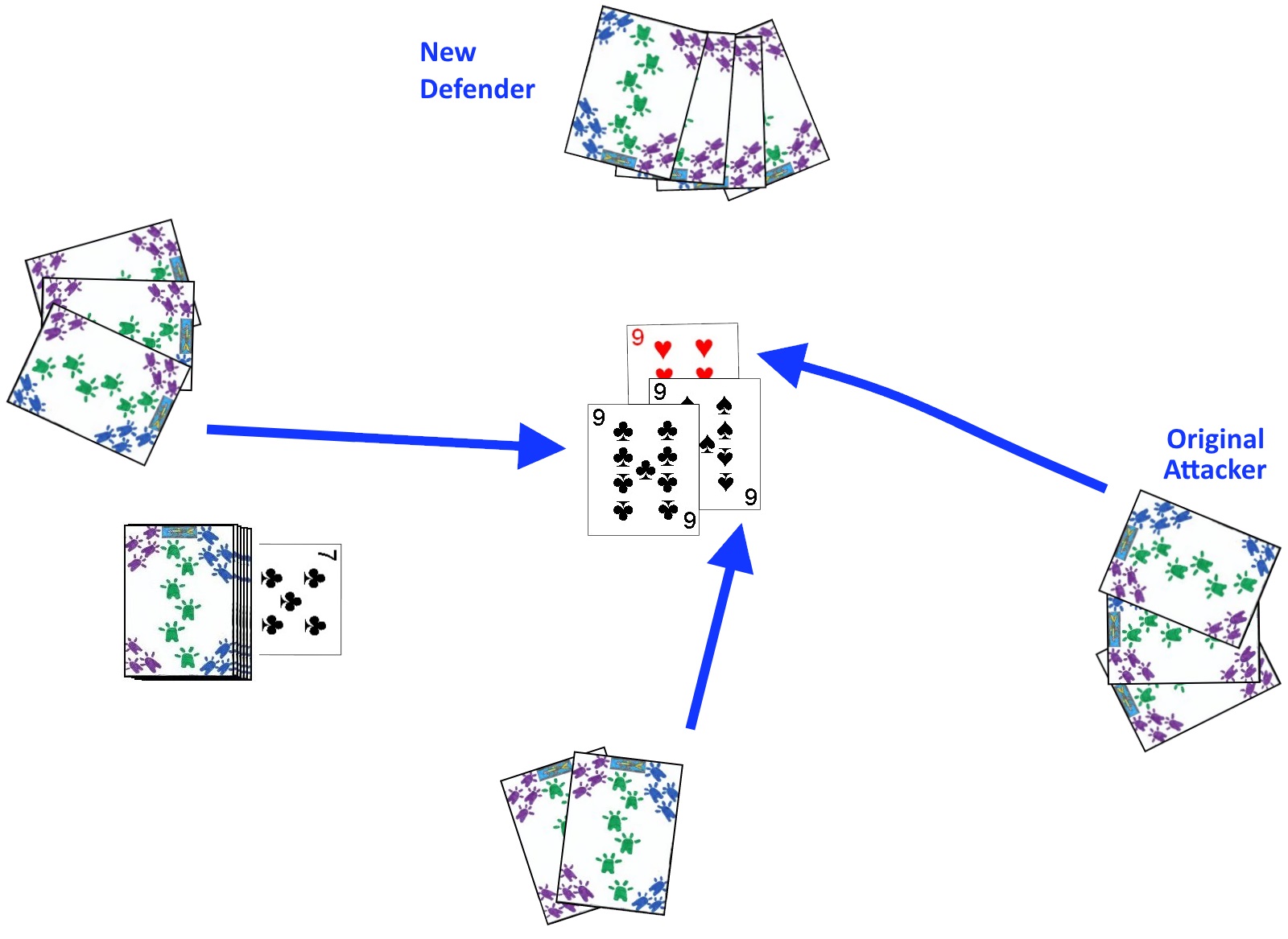 Passing
Passing: The basic variant described above (called throw-in or podkidnoy) is the most common version of Durak to be played. However, there are several other variants that are often seen. One of these is the passing variant (called perevodnoy). This variant allows a defender to pass the attack in certain instances.
Thus, if a defender has a card of identical rank as that played by the attacker he my opt (but is not required) to pass the attack to the next player in turn. To do this, this first defender would add his own card of the same rank onto the current attacking card. In this case, the first defender then becomes the new attacker and the player to his immediate left the new defender. This player must then beat this and any other undefended cards still on the table. The new defender may also pass the attack to the next player if he also has a card of the same rank as the current attack card on the table. However, in order to make a pass of multiple current undefended attack cards, he would need to ensure he either beats some of the undefended cards or has a card of equal rank to all the currently undefended attack cards on the table. A player may never pass to the next player if that next player has fewer cards remaining in hand then are currently undefended on the table. This can continue until the next defender does not have a card that is the same rank as one of the undefended cards on the table. In all other aspects this version is played identically to the standard version described above.
Travel Document: Also called Flash, this is another variant of the base game which involves passing. This variant is played identically to the standard passing variant with one key exception. If the newly defending player has the trump card of the same denomination as the attack card played by the attacker, he simply shows the card and this player then becomes the new attacker. The card played by the original attacker is still considered the attack card in which the new defender will be required to defend against. In all other aspects, this version is played identically to standard Passing Durak.
Full Deck: Some players prefer to use the entire 52 card deck when playing the game. The ranking of the cards in this larger deck is as follows (from high to low); Ace, King, Queen, Jack, 10, 9, 8, 7, 6, 5, 4, 3, 2.
This variant can allow more players (up to about 8), and each player normally receives 7 cards in the deal. In all other aspects, this variant of the game is the same as the standard version described at the top of the page.
Partnership Durak: Although Durak is usually played with each playing for himself, a partnership variation also exists. This variant is usually played by four players playing in two partnerships. The partners should sit directly across from each other at the game table.
This variant is played identically to standard Durak with just a few differences. In partnership Durak, a player may never add a card to an attack in which his partner is the defender. The first player to completely deplete his hand of cards is declared the winner. The game then continues from this point with the remaining player playing independently exactly as in standard Durak until only one player remains with cards.
Six players can also participate in two partnerships of three players each. In this variant, after the partnerships have been decided, the players should sit at the table in such a manner that rotation of play alternates between players of each team. When playing this variant, the full 52 card deck should be used.
Musta Maija: Musta Maija is fun game of the shedding variety which shares many commonalities with Durak and its variations. Musta Maija is a card game of Finnish descent played by both children and adults. This game also goes by the name Black Maria, but this game should not be confused with the popular Hearts variant that also goes by that name
as well.
The game uses one standard 52 card deck, and is designed to be played by 3 to 5 players. The ranking of the cards in the deck is as follows: Ace, King, Queen, Jack, 10, 9, 8, 7, 6, 5, 4, 3, 2. Determination of seating positions and first dealer can be performed in a variety of ways, with drawing for the highest card a common method. Each player would take his choice of seat at the table in order from highest to lowest. The player drawing the highest card of all becomes the first dealer. Thereafter the deal rotates in a clockwise rotation around the table.
After the players are seated and the first dealer selected, he thoroughly shuffles the deck and passes it to the player to his right for a cut. After the cut, the dealer then begins dealing, one face-down card at a time in a clockwise rotation. He begins with the player to his immediate left. He continues dealing until each player has a total of five cards. He then places the remainder of the deck face-down in the center of the table as the stock.
A special trump card will also be exposed by the dealer for the hand. However, this card is exposed immediately after the first Attacker has played his attack cards to the table. After that player plays his first set of cards (as described below) the dealer then exposes the top card of the stock and places it face-up, partway under the stock. The suit of this card sets the trump suit for the hand. However, if this card is of the suit of Spades, the card is randomly placed back into the center of the pack and the next card from the stock is drawn. If this next card is also a Spade, he does the same thing, repeating this until he draws a card other than a Spade to be set as the trump suit for the hand. Since players will, through the course of the game, draw cards from the stock to replenish their hands, the last card of the stock is considered this face-up trump card
and will be drawn as the last card from the stock as necessary. The player to the immediate left of the dealer has the first turn.
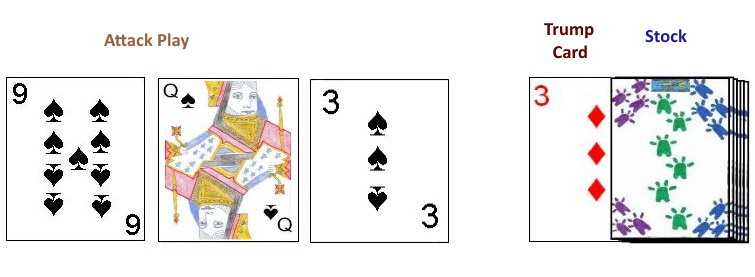
The goal of Musta Maija is similar to most other games related to Durak, which is to play the last of one's cards to the table, as the last player to do so is said to lose the game.
Each turn consists of the player whose turn it is placing a number of cards on the table, as an attack. The cards placed must all be of the same suit and he cannot play more cards to the table than the player to his left has cards remaining currently in his hand. The cards should be each placed in a row on the table,
in any order, all exposed. The player may play any number of cards as
long as all the cards are of the same suit. This same player should then draw an equal number of cards from the stock to replenish his hand to five cards (if he has less then five cards currently in hand). If the stock becomes exhausted, a player does not draw any additional cards and simply completes the hand with the cards remaining in hand. After the attack cards are played, the player to that player's left then attempts to defend against this attack. In order to defend against a specific attack card, he may play a card of the same suit but of a higher rank. If the cards played by the attacker are not of the trump suit, he may also beat the card by playing any card of the trump suit on top of the card. After the Defender plays any cards he intends to play to attempt to beat the attackers cards, he also draws from the stock to replenish his hand to five cards as appropriate. If the stock is empty, he draws no cards and simply continues play with the cards left in his hand. After the Defender has beaten any cards he is capable (and willing) to beat, any beaten cards (and the cards used to beat them) are set aside in a discard pile, out of play. Any cards the Defender was unable (or chose not) to beat, he must take from the table into his own hand.
If the Defender was able to beat every card played by the attacker, all the attacking and defending cards are removed from play, and the turn moves to the Defender who becomes the new attacker (with the player at his left becoming the
Defender). However, if the Defender was unable (or elected not) to beat all the attacking cards, he must take any unbeaten cards into his hand and the turn moves to the player to the Defender's immediate left.
The Queen of Spades (called Maija or Black Maria), is a special card
in this game. Although considered a member of the suit of Spades, it can only be played during an attack (as it can not beat any other cards). However, when played during an attack, no other card can be used to beat this card by a Defender.
Once the stock pile is exhausted and a player plays the last of his card, he drops from the game. The last player to have cards remaining in his hand is said to have lost the game.
Panjpar: Panjpar is another game of this type which gained notoriety as the game was prominently featured in the novel and later film
The Kite Runner by Khaled Hosseini. In the story as well as in real-life, Panjpar is a favorite game in the Nation of Afghanistan and the name of the game can be translated to "Five Cards". It is played similarly to Durak, specifically Prostoy Durak
(to be described shortly).
Panjpar is a two-player game, played using one standard 52 card deck. The ranking of the cards in this deck are as follows (from high to low): Ace, King, Queen, Jack, 10, 9, 8, 7, 6, 5, 4, 3, 2.
Determination of the first dealer can be performed using a variety of methods, with draw of high cards a common method. Using this method, each player would draw a card from the shuffled deck, with the player drawing the higher card set as the first dealer. If both players draw cards of equal rank, they would each discard the previous card drawn and draw another. The player drawing the highest such card is set as the first dealer, and thereafter the role of dealer alternates amongst the two players after each hand.
Before beginning the deal, the dealer's opponent should then take a guess as to what color he believes the trump suit will be (red or black). If he is correct, he has the first play, and if incorrect his opponent the dealer has the first play of the hand.
Once the dealer has been determined he should thoroughly shuffle the deck and offer it to his partner to cut. After the cut, the dealer begins dealing the cards, one at a time and face-down starting with his opponent. He continues dealing until each player has a five card hand. The next card is then dealt face-up to the center of the table to determine the trump suit for the hand. The suit of this card sets the trump suit to be used during the hand (called rang). After dealing this card, the dealer then places the remainder of the deck partially covering the trump card and a right angle. This pile of cards is the stock pile.
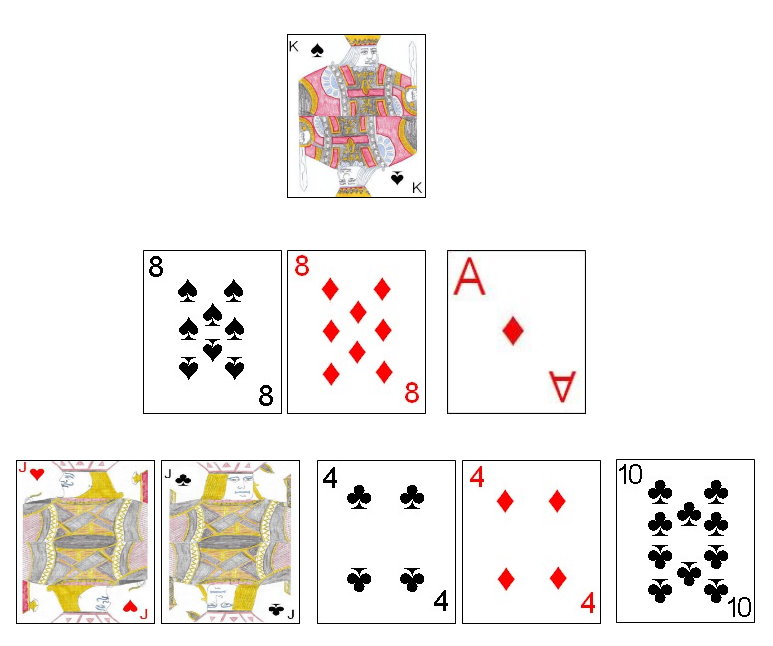
Whichever player was determined to play first has the first move (called an attack). An attack consists of the player playing one, three or five cards face-up to the table from his hand. If playing a single card, the player may play any card from his hand. However, there are certain rules that must be followed in playing multiple cards (three or five) during an attack play. If playing three cards, these cards must consist of two cards of the exact same rank and any third card of that players choice. If the attack consists of five cards, these cards must consist of two pairs and any fifth card of the player's choice. The cards forming the attack are usually set in a row on the table such that each can be clearly seen by both players.
After the attack play, his opponent then attempts to defend against this attack. On his turn this player attempts to beat each individual card in the attack play with a card from his own hand. A card which is played to beat another card is played directly on top of the attack card to which it will beat. In order to beat such a card, the card must be of the same suit and a higher rank. If the attack card is not in the trump suit, it may also be beaten by any card of the trump suit. The defender may beat as many or as few of the attack cards as he chooses (and is able).
Each card from the attack that was beaten (as well as the card that was used to beat it) are set aside and out of play for the remainder of this hand. If the defender manages to beat every attack card played during that attack, all the cards from the attack are set aside and the previous defender then becomes the new attacker and the previous attacker becomes the new defender. If the defender could not, or elected not to beat all the attack cards, he must take any unbeaten attack cards into his own hand, and the previous attacker retains the role of attacker for the next play.
Each player should then draw cards from the stock to replenish his hand to five cards (if he currently has less than five cards in his hand), starting with the attacker. The face-up trump card is considered the last card in the stock. Once the stock is depleted, additional cards are no longer drawn, although each player at his turn to draw, will draw any required cards as able.
Once the stock has been depleted, one or both players may have fewer than five cards in hand (which is expected). Thus, a player may never make an attack consisting of more cards than his opponent has remaining in his hand.
If after a round consisting of an attack and the corresponding defense (called a battle), if one player finds he has no cards remaining in his hand (once the stock has become exhausted), he is declared the winner of the game. However, if the defender manages to beat each of the attackers card, and both players have no more cards remaining in hand, that game is considered a draw.
Prostoy Durak: It appears the Afghan game Panjpar described directly above is derived from the game Prostoy Durak. In fact, Prostoy Durak is played identically to Panjpar with the following exceptions:
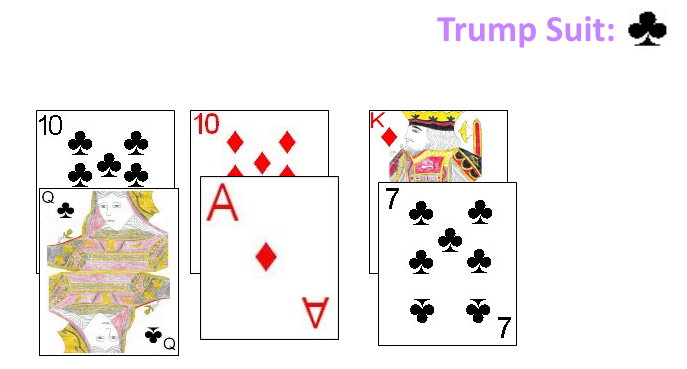
- Prostoy Durak is designed to be played by two, three or four players, each playing independently.
- The deck used for Prostoy Durak consists of the standard deck in which all cards of rank five and lower are removed. The ranking of the remaining cards in the deck used for this game are as follows (from high to low): Ace, King, Queen, Jack, 10, 9, 8, 7, 6.
- After each deal in this game the cards are not cut. After the first hand, the loser of the last hand deals the next.
- The player to the immediate left of the dealer has the first play (attack). The next player in clockwise rotation from the attacker is the defender of this attack and tries to beat any or all the cards in the attack.
- If the defender manages to beat all the cards played by the attacker, all cards used in the attack and defense are set aside out of play and the defender becomes the new attacker and the player at the defender's immediate left the next defender. If the defender beats some (but not all) of the attack cards, the beaten cards (and the cards which beat them) are set aside out of play, any unbeaten cards are added to the defenders hand, and the player to the immediate left of the defender becomes the new attacker and the player to that player's right becomes the new defender. If none of the cards in the attack were beaten by the defender, the defender takes all the cards from the attack into his hand and the player at the left of the defender becomes the new attacker.
- If a player has the card of rank six in the trump suit, he may exchange this card with the face-up trump indicator card at any time.
- After each battle, the attacker and defender draw sufficient cards from the stock to replenish the hand to five cards, if able, starting with the attacker. Once the stock is
exhausted (including the trump indicator card which is considered the last card of the stock), players no longer draw from the stock.
- If, after a battle a player finds that he has depleted his hand he drops from the game. If a player who runs out of cards was set to be the next attacker, the attack would rotate to the next active player holding cards to that player's left.
- The game continues until all players but one have managed to play their last card. This last player is considered the loser of that hand (called fool). The loser of each hand collects one negative game point. After a set number of games the player with the fewest negative game point is declared the overall winner.
- If the last two active players in any hand both manage to play the last card (with no requirements to take cards from the center), the game is considered a draw with no loser for that hand.
In all other aspects Prostoy Durak is played identically to Panjpar.
Copyright © 2015
CatsAtCards.com. All rights reserved.
 The attacker begins by selecting any card from his hand placing it
face up on the table. The defender must then respond by attempting to
play a higher card of his own if he has one. If a card of the trump suit
was played, any higher ranked card of the trump suit can beat it. If a
non-trump card was played, a higher ranked card of any suit can beat it,
as can any card of the trump suit. The defender's card should be played on
top of the attacker's card.
The attacker begins by selecting any card from his hand placing it
face up on the table. The defender must then respond by attempting to
play a higher card of his own if he has one. If a card of the trump suit
was played, any higher ranked card of the trump suit can beat it. If a
non-trump card was played, a higher ranked card of any suit can beat it,
as can any card of the trump suit. The defender's card should be played on
top of the attacker's card.

 The goal of Musta Maija is similar to most other games related to Durak, which is to play the last of one's cards to the table, as the last player to do so is said to lose the game.
The goal of Musta Maija is similar to most other games related to Durak, which is to play the last of one's cards to the table, as the last player to do so is said to lose the game.
 Whichever player was determined to play first has the first move (called an attack). An attack consists of the player playing one, three or five cards face-up to the table from his hand. If playing a single card, the player may play any card from his hand. However, there are certain rules that must be followed in playing multiple cards (three or five) during an attack play. If playing three cards, these cards must consist of two cards of the exact same rank and any third card of that players choice. If the attack consists of five cards, these cards must consist of two pairs and any fifth card of the player's choice. The cards forming the attack are usually set in a row on the table such that each can be clearly seen by both players.
Whichever player was determined to play first has the first move (called an attack). An attack consists of the player playing one, three or five cards face-up to the table from his hand. If playing a single card, the player may play any card from his hand. However, there are certain rules that must be followed in playing multiple cards (three or five) during an attack play. If playing three cards, these cards must consist of two cards of the exact same rank and any third card of that players choice. If the attack consists of five cards, these cards must consist of two pairs and any fifth card of the player's choice. The cards forming the attack are usually set in a row on the table such that each can be clearly seen by both players.
